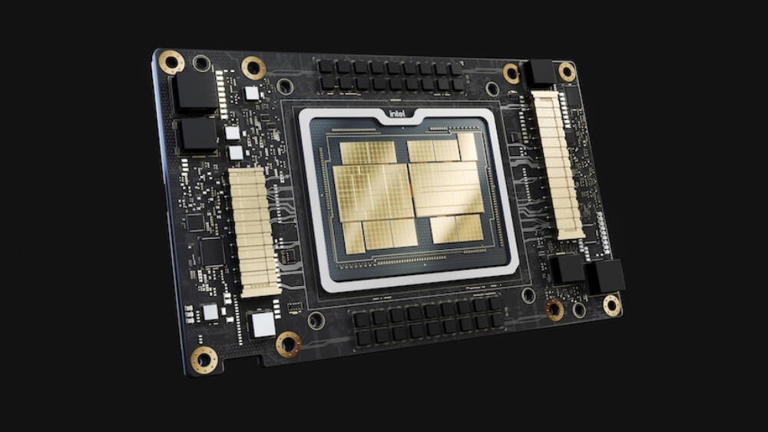Now Intel simply needs to ship a compatible CPU
HOT CHIPS Intel offered the closest glimpse yet at its front runner datacenter GPU, code named “Ponte Vecchio”, at Hot Chips this week, with its own inner benchmarks showing the chip outmatching AMD’s MI250x as well as competing neck and neck with Nvidia’s upcoming H100 GPU … Revealed in 2015, Ponte Vecchio is Intel’s very first significant run at providing a high-performance GPU for AI/ML as well as HPC applications. The chip itself is really a series of memory and compute passes away glued with each other using a mix of Intel’s Foveros as well as EMIB packaging tech into a “stack” with 2 such heaps per accelerator.
Click Here – New Social media for beginners
According to Intel Fellow Hong Jiang
these heaps can act like a pair of GPU passes away or as a solitary rational die relying on application requirements.
Intel declares Ponte Vecchio will certainly deliver 52 teraflops of, based on a layout choice, allows the exact same top FP32 as well as FP64 efficiency, putting it simply ahead of AMD’s 47.9 Tflop (FP64) MI250X revealed in 2014, and within spitting range of the H100’s 60Tflops (FP64).
As a side note, usually FP32 is double FP64 as the accuracy is reduced, yet intel chose to limit FP32 efficiency, going on a the same level with FP64. Most likely, it believes FP64 as well as AI-suitable accuracy are more crucial these days than 32-bit floating point.”
Intel likewise talked about the performance of its XMX matrix accelerators at Hot Chips, which are comparable in numerous areas to Nvidia’s tensor cores. In single-precision matrix estimations– tensor float– Intel claims the GPU will certainly supply 419Tflops of performance.
Several of the efficiency can be attributed to Ponte Vecchio’s large caches with include a 64MB register file, 64MB of L1 cache, 408MB of L2 cache, and also 128GB of HBM memory.
Technology for AMD
” This truly helps us to keep information on die instead of needing to go bent on the HBM memory,” Jiang claimed.
Both Intel and also Nvidia’s GPUs are reliant on PCIe 5.0 for connection to the host which implies comparing them to AMD’s PCIe 4.0-based MI200-series GPUs isn’t exactly an apples-to-apples comparison.
The brand-new PCIe specification provides twice the transmission capacity to the host, yet requires a next-gen CPU from either Intel and also AMD, neither of which are available yet.
As well as while Nvidia might quickly opt for AMD’s Epyc 4 chips when they introduce this autumn or utilize its very own Poise CPUs, Intel appears to be sticking to an all Intel style.
At HotChips officers showed off four fluid cooled down Ponte Vecchio GPUs paired with 2 of its long-delayed Sapphire Rapids Xeon Scalable cpus in a 1U framework. However, Jiang notes that approximately eight GPUs can be connected to a single node making use of the firm’s Xe Link textile.
The most up to date day has actually apparently pushed the chip back up until Q1 2023, greater than a year and half after it was expected to release.
Consequently Intel could be left waiting with a perfectly great GPU for its CPU department to supply Sapphire Rapids.
By the time Ponte Vecchio in fact arrives the comparison may be far less beneficial.
AMD is slated to launch its Instinct MI300 accelerators in 2023
which its invoicing as the “very first datacenter APUs.”
The chips will certainly include a Zen 4 cpu co-packaged along with a CDNA 3-based GPU. In a presentation this spring, AMD asserted APU would certainly provide an eight-fold performance enhancement over the MI250X, though its not clear who that will reflect in terms of real world performance.
If this seems acquainted that’s since Intel, Nvidia, and AMD have actually all been trending in this direction. At GTC this springtime, Nvidia disclosed its Grace-Hopper Superchip, which sets its Arm-based Elegance CPU with a GH100 GPU, and 512MBs of LPDDR5X as well as 80GBs of HBM3 memory on a single 1000W bundle.
Also Read – Audi’s F1 strategies form as Sauber news looms
No to be excluded, Intel introduced comparable prepare for its Falcon Shores XPU in May, which will see the chipmaker merge its HBM-equipped Sapphire Rapids CPU and also Ponte Vecchio GPU pile right into a single bundle.
Intel declares the system will certainly supply a five-fold renovation in performance-per-watt, memory ability, and also transmission capacity compared to “present systems.”
Ponte Vecchio not only faces competitors from Nvidia as well as AMD, but if kept back much longer the chip can discover its life expectancy interrupted by its follower, code word Rialto Bridge.
We’ve really seen this occur once before with Intel’s 11th-gen Rocket Lake CPUs which introduced in very early 2021 only to be changed a few months later on by the much superior Alder Lake rejuvenate, which supplied considerable performance, core matter enhancements, and also procedure improvements.
Rialto Bridge, which is supposed to start tasting next year, will see Intel up the power intake to 800W per component as well as will need liquid cooling.
